Attack of the Clones appears in an aspect ratio of approximately 2.35:1 on this single-sided, double-layered DVD; the image has been enhanced for 16X9 televisions. Transferred straight from the original digital photography, Clones never saw a frame of film, and that showed during this excellent picture.
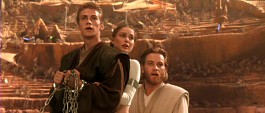 Sharpness seemed flawless. The image looked crisp and detailed from start to finish. I noticed virtually no examples of softness throughout this distinct and well-defined presentation. Jagged edges and moiré effects also created no concerns, and unlike Menace, edge enhancement never reared its ugly head. Since Clones never touched film, obviously it didn’t suffer from any print flaws either; the picture looked clean and fresh.
Sharpness seemed flawless. The image looked crisp and detailed from start to finish. I noticed virtually no examples of softness throughout this distinct and well-defined presentation. Jagged edges and moiré effects also created no concerns, and unlike Menace, edge enhancement never reared its ugly head. Since Clones never touched film, obviously it didn’t suffer from any print flaws either; the picture looked clean and fresh.
The many settings of Clones meant that it offered a myriad of different colors, and the DVD replicated them nicely. From the vivid neons of the Coruscant nightclubs to the natural and romantic palette of Naboo to the foreboding reds of the droid factory, the tones always appeared tight and concise. The colors seemed vivid and lively at all times, and they lacked any signs of noise, bleeding, or other concerns. Black levels remained deep and rich, while shadow detail appeared appropriately dense but not overly thick. Frankly, I didn’t think Clones looked quite as spectacular as the best animated DVDs such as Toy Story 2, but it presented a terrific visual presentation across the board. It certainly blew away the moderately disappointing picture seen during Menace.
Although many faulted the visual presentation of Menace, few criticized its audio. I can’t imagine anyone will slam the Dolby Digital 5.1 EX soundtrack of Attack of the Clones either, as it matched up nicely with its predecessor. As with the first film, this was an amazing piece of work, and it also offered one of the smoothest and most enveloping soundfields I’ve ever heard. All five channels received a very active workout, as they were used for the vast majority of the film. Music remained mostly anchored to the front, where the score benefited from solid stereo separation and presence, but it also spread warmly to the surrounds. Some speech emanated from side and rear speakers at times as well.
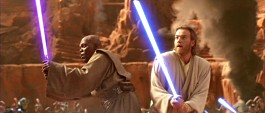 Ultimately, though, the effects were the stars of the show, and they made this an incredible experience. Throughout the film, elements both loud and soft appeared from all around, and the mix melded together in a tremendously clean and believable manner. A great deal of unique audio cropped up in each speaker, and these pieces moved smoothly from channel to channel, with a presence that seemed to be virtually seamless. Nothing ever felt forced or awkward as it transitioned; instead, the elements cruised past us neatly. It was a wonderfully well-integrated soundfield that added to the film’s overall impact.
Ultimately, though, the effects were the stars of the show, and they made this an incredible experience. Throughout the film, elements both loud and soft appeared from all around, and the mix melded together in a tremendously clean and believable manner. A great deal of unique audio cropped up in each speaker, and these pieces moved smoothly from channel to channel, with a presence that seemed to be virtually seamless. Nothing ever felt forced or awkward as it transitioned; instead, the elements cruised past us neatly. It was a wonderfully well-integrated soundfield that added to the film’s overall impact.
Audio quality also seemed to be excellent. Some dialogue showed its looped roots – a few lines didn’t fit the action well – but as a whole I thought the speech appeared natural and warm, and I heard no problems related to intelligibility or edginess. One area in which the track actually improved over Menace related to the music. I felt the score sounded a little lackluster at times during that film, but John Williams’ compositions came across as notably more dynamic and lively in Clones. I felt consistently impressed with the bold and vivid music that showed up throughout the movie.
The effects dominated the proceedings and really livened up the flick. Across the board, these elements seemed to be extremely bold and aggressive, but they maintained excellent fidelity and showed no signs of distortion or harshness. A great deal of effort went into creating most of the stems, as much of the film used sounds that don’t exist in real life. They always appeared to be clear and realistic, and they sounded quite strong.
Low-end presence deserves a paragraph unto itself. While Clones cranked my subwoofer almost non-stop from start to finish, the bass never became overwhelming or excessive. My biggest complaint about The Lord of the Rings: The Fellowship of the Ring stemmed from the film’s ridiculously overactive LFE channel; that material often seemed overdone and distracting. Considering the heavy use of the subwoofer in Clones, it risked the same problem, but the mix balanced and integrated the bass in a much smoother manner. Low-end information complemented and added punch to the proceedings without dominating them. Maybe another movie used bass this well, but I can’t think of any competition for Clones in that department right now.
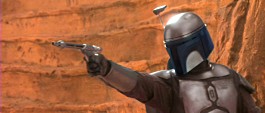 With Menace, I easily selected the best auditory segments of the film, but my choices didn’t seem quite so obvious for Clones. So much of the movie worked so well that I couldn’t decide readily. The chase through the asteroid belt certainly offered a terrific segment, though, and the entire final 45 minutes or so of the film could be utilized as demo material. I won’t discuss it in detail to make sure I don’t include any spoilers, but that segment of the movie simply cranked out boohoogles of memorable auditory bits. However, the whole flick really provided a tremendous amount of stellar sound, and Clones stands as one of the best soundtracks you’ll find.
With Menace, I easily selected the best auditory segments of the film, but my choices didn’t seem quite so obvious for Clones. So much of the movie worked so well that I couldn’t decide readily. The chase through the asteroid belt certainly offered a terrific segment, though, and the entire final 45 minutes or so of the film could be utilized as demo material. I won’t discuss it in detail to make sure I don’t include any spoilers, but that segment of the movie simply cranked out boohoogles of memorable auditory bits. However, the whole flick really provided a tremendous amount of stellar sound, and Clones stands as one of the best soundtracks you’ll find.
One note: the DVD did not feature the original “burned-in” subtitles seen theatrically. This technique irritates many folks, and I can understand their concerns; player-generated text such as this often doesn’t blend very well with the action and it becomes a distraction. Such was the case with Clones. I thought the non-original subtitles looked “off” and they didn’t fit the film neatly. There wasn’t a lot of translated text, so this wasn’t the end of the world, but I would have definitely preferred to see the original subtitles.
Anyone who watched the Phantom Menace DVD will feel right at home as they proceed through the supplements found on the two-disc release of Attack of the Clones. I regard that as a good thing, for I felt the older package included a terrific roster of extras. For the most part, Clones came across as a close cousin of the first set, with another nice set of materials.
Most of these appeared on DVD Two, but the first platter included a few bits, starting with an audio commentary. This track featured director/writer George Lucas, producer Rick McCallum, editor/sound designer Ben Burtt, animation director Rob Coleman, and visual effects supervisors Pablo Helman, Ben Snow and John Knoll. Although the commentary remained fairly screen-specific – the speakers clearly watched the movie as they spoke - most of the participants appear to have been recorded separately. I got the impression Coleman, Knoll and Helman sat together but the rest remained on their own, though I could be mistaken.
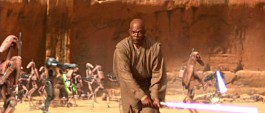 That was fine with me, as I thought the format allowed for a fair amount of spontaneity but it came across as a tight, well-edited piece. As a whole, the commentary offered a lot of very solid information. Due to the qualifications of most of the participants, technical realms dominated the proceedings, but not to the degree one might anticipate. The discussion moved briskly across effects issues and overall story points, and Lucas was a very active speaker. He talked about a mix of issues that concerned him, such as character and plot points as well as various production challenges. McCallum also contributed notes about that last topic.
That was fine with me, as I thought the format allowed for a fair amount of spontaneity but it came across as a tight, well-edited piece. As a whole, the commentary offered a lot of very solid information. Due to the qualifications of most of the participants, technical realms dominated the proceedings, but not to the degree one might anticipate. The discussion moved briskly across effects issues and overall story points, and Lucas was a very active speaker. He talked about a mix of issues that concerned him, such as character and plot points as well as various production challenges. McCallum also contributed notes about that last topic.
The others provided a slew of fun facts about the technical side, and Burtt tossed out good notes that reflected his dual role on the flick. If you liked the commentary for Menace, you should enjoy this one, for the two offered similar material. However, don’t take that to mean that this one just reiterated information from the earlier track, as it consisted of details specific to Clones. It used an identical format, though, and it came across as a very similar piece that I thoroughly enjoyed.
Although there was no text version of the commentary, the track offered subtitles to identify the onscreen speakers. This was a terrific touch. It worked better than spoken introductions, because it didn’t interfere with the flow of the program, and the text popped up whenever the speaker changed.
Also on DVD One was the THX Optimizer program. It purports to help you set up your home theater to best present the movie on the disc in question. Apparently the Optimizer is unique for each DVD on which it’s included; unlike programs such as Video Essentials, the Optimizer should tweak your set-up differently every time. Frankly, I’ve been very happy with my already-established calibration and I’m afraid to muck with it, so I’ve never tried the Optimizer. If you lack calibration from Video Essentials or a similar program, or if you’re just more adventurous than I, the Optimizer could be a helpful addition.
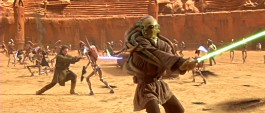 Some Easter Eggs appeared on DVD One. You can choose to vary the main menu screen and select any of the three choices – Coruscant, Kamino, and Geonosis – via selections made during the “Attention” screen when the DVD starts. For Coruscant, hit “Audio” on your remote, while you should punch “2” for Kamino. Geonosis is more complicated; enter “10+”, “2” and “2” for it. Or just let them come up randomly and save some battery power. (Truth in advertising: I’ve heard others tell that these selections work, but I couldn’t get them to happen. It’s true – I’m so lame!)
Some Easter Eggs appeared on DVD One. You can choose to vary the main menu screen and select any of the three choices – Coruscant, Kamino, and Geonosis – via selections made during the “Attention” screen when the DVD starts. For Coruscant, hit “Audio” on your remote, while you should punch “2” for Kamino. Geonosis is more complicated; enter “10+”, “2” and “2” for it. Or just let them come up randomly and save some battery power. (Truth in advertising: I’ve heard others tell that these selections work, but I couldn’t get them to happen. It’s true – I’m so lame!)
More interesting is DVD One’s other egg, a cute little gag reel. This brief piece includes DVD production credits and some goofs on the set, most of which showed Hayden Christensen as he frequently stumbled. To get this, go to the “Options” screen and hit “10+” and “1” to make “11”, then punch “3” and “8” and you’ll go to this feature. Alternately, you can go straight to title 3 while you watch the movie.
Finally, DVD One finishes with some DVD-ROM-based Weblinks. You’ll find connections to the official Star Wars site at www.starwars.com as well a DVD-related site. As I write this about five weeks prior to the disc’s release, the latter offers nothing specific to Clones, but I’m sure that’ll change when the DVD hits the shelves.
In addition, the DVD-ROM area includes a link to “Holonet News”. This fun site provides information from the Star Wars point of view. For example, it treats the failed attempt to assassinate Padme as a news item. This page offers a well-done and entertaining piece.
One note about the DVD-ROM links: unlike most discs, these don’t come up automatically when you stick the DVD in your drive. Instead, you need to run the disc as usual and then go to the “starwars.com” section on it. This will allow you to access the weblinks.
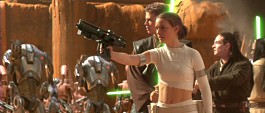 As we move to DVD Two, we find the bulk of the supplements, and these appear within different domains. The Documentaries section includes two different programs. On The Phantom Menace, we found an absolutely superb piece called “The Beginning” that gave us a general look at the production from start to finish. For Clones, the DVD’s main documentary takes an alternate approach. From Puppets to Pixels: Digital Characters In Episode II sticks with the world of effects. Structured like “The Beginning”, the 52-minute and 19-second show mostly offers behind-the-scenes footage of work as it happened. Interviews blend with these shots in a way that keeps the emphasis on the actions; very few “talking head” shots occur. We hear from George Lucas, animation director Rob Coleman, digital modeling supervisor Geoff Campbell, visual effects supervisor John Knoll, concept design supervisor Doug Chiang, editor Ben Burtt, stunt coordinator Nick Gillard, actor Christopher Lee, animator Kevin Martel, lead animator Linda Bel, and animation supervisor Hal Hickel.
As we move to DVD Two, we find the bulk of the supplements, and these appear within different domains. The Documentaries section includes two different programs. On The Phantom Menace, we found an absolutely superb piece called “The Beginning” that gave us a general look at the production from start to finish. For Clones, the DVD’s main documentary takes an alternate approach. From Puppets to Pixels: Digital Characters In Episode II sticks with the world of effects. Structured like “The Beginning”, the 52-minute and 19-second show mostly offers behind-the-scenes footage of work as it happened. Interviews blend with these shots in a way that keeps the emphasis on the actions; very few “talking head” shots occur. We hear from George Lucas, animation director Rob Coleman, digital modeling supervisor Geoff Campbell, visual effects supervisor John Knoll, concept design supervisor Doug Chiang, editor Ben Burtt, stunt coordinator Nick Gillard, actor Christopher Lee, animator Kevin Martel, lead animator Linda Bel, and animation supervisor Hal Hickel.
“Pixels” mainly focuses on four different effects challenges: Yoda, Dexter Jettster, Taun We, and the digital version of Obi-Wan used in some shots. A few other issues receive attention as well; for example, we learn a little about Christopher Lee’s double and the way digital effects helped blend the two men together onscreen. Otherwise, the show mostly documents the four topics I mentioned. Although “Pixels” seems pretty entertaining and informative, it comes as a moderate disappointment after “The Beginning”. I found the latter to offer one of the all-time great DVD documentaries, as it provided a wonderfully candid and lively view of the production. With its smaller scope, “Pixels” can’t do that, and it becomes somewhat monotonous at times; I can only stand so many shots of people sitting in front of computers.
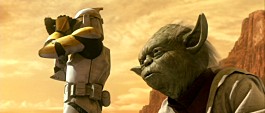 But I don’t want to slam “Pixels” simply because it doesn’t match up to “The Beginning”; very few DVD documentaries equal that excellent program. I enjoyed “Pixels” as a whole, despite some slow patches. The experiential presentation helped make it more enjoyable. I always like programs that offer looks at work in action, and this one nicely mixed narrative information with appropriate visuals. Probably its best moment comes when we watch Lucas and the animators struggle with “The Widowmaker”, a key Yoda line that they found difficult to accurately deliver. Ultimately, “Pixels” provides an entertaining and involving documentary for those with an interest in effects.
But I don’t want to slam “Pixels” simply because it doesn’t match up to “The Beginning”; very few DVD documentaries equal that excellent program. I enjoyed “Pixels” as a whole, despite some slow patches. The experiential presentation helped make it more enjoyable. I always like programs that offer looks at work in action, and this one nicely mixed narrative information with appropriate visuals. Probably its best moment comes when we watch Lucas and the animators struggle with “The Widowmaker”, a key Yoda line that they found difficult to accurately deliver. Ultimately, “Pixels” provides an entertaining and involving documentary for those with an interest in effects.
Also found in the “Documentaries” area, State of the Art: The Previsualization of Episode II lasts 23 minutes and 29 seconds and provides a look at the prep work done for the film’s visual effects. It mixes behind-the-scenes footage with interviews. We hear from Lucas, producer Rick McCallum, visual effects supervisors Ben Snow and John Knoll, animation director Rob Coleman, editor/sound designer Ben Burtt, pre-visualization supervisor Dan Gregoire, and concept design supervisors Eric Tiemens and Ryan Church. “Art” seems like a more traditional documentary than “Pixels”, as it provides standard interview shots and less “experiential” narration.
Nonetheless, it comes across like a good look at the topic. After a general introduction to the subject, we examine the work done for three specific segments of the film: Speeder Chase, Droid Factory, and Clone War. The program concludes with “George’s Science Experiment”, a closing discussion of the use of digital technology. Obviously the focus here remains on technical domains, but “Art” manages to avoid becoming too dry or stiff. Instead, it offers a lively and involving discussion of the ways effects shots are planned and executed. It brings out a lot of good information and does so in an entertaining manner.
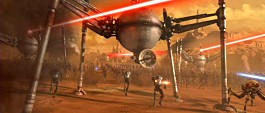 Next we found a presentation of eight Deleted Scenes. Presented anamorphic 2.35:1 with Dolby Digital 5.1 sound, each segment lasts between 40 seconds and 140 seconds for a total of 12 minutes, 15 seconds of footage. As a serious Star Wars geek, I enjoyed being able to see this unused material, but none of it seemed terribly valuable. Mostly we found character moments that included Padme. On their own, these had some merit, but they deserved to be cut from the final film. I argued that the deleted bits from Menace might have worked in the finished product, but I won’t do so here. Nonetheless, they’re fun to watch.
Next we found a presentation of eight Deleted Scenes. Presented anamorphic 2.35:1 with Dolby Digital 5.1 sound, each segment lasts between 40 seconds and 140 seconds for a total of 12 minutes, 15 seconds of footage. As a serious Star Wars geek, I enjoyed being able to see this unused material, but none of it seemed terribly valuable. Mostly we found character moments that included Padme. On their own, these had some merit, but they deserved to be cut from the final film. I argued that the deleted bits from Menace might have worked in the finished product, but I won’t do so here. Nonetheless, they’re fun to watch.
The deleted scenes can be viewed with or without introductions. Those include comments from George Lucas, Ben Burtt, and Rick McCallum. Each man helps tell us background about the segments and also lets us know why the pieces failed to make the final cut. I liked this information and found it to be helpful.
Next we go to the Featurettes area, which includes three separate programs. All together, these fill 26 minutes and 49 seconds of material. Story lasts nine minutes and acts as a glorified trailer. It includes many clips from the movie as well as a few shots from the set and comments from George Lucas, producer Rick McCallum, and actors Samuel L. Jackson, Ewan McGregor, Hayden Christensen, Natalie Portman, Christopher Lee, and Ian McDiarmid. They loosely discuss the plot and the characters, but it suffers from too many movie scenes and too little insight.
Love runs nine minutes, 37 seconds, and it uses the same structure as “Story”. We hear from Lucas, McCallum, Portman, Christensen, Jackson, McGregor, composer John Williams, costume designer Trisha Biggar. This program doesn’t offer any greater depth than “Story”. Clearly promotional in nature, it chats about the romance between Padme and Anakin, but it doesn’t really offer anything particularly interesting.
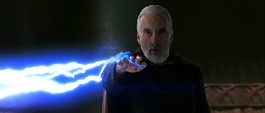 Lastly, Action goes for eight minutes and 11 seconds and it duplicates the same kind of content found in the first two featurettes. Here we hear from Lucas, McCallum, Jackson, Portman, Lee, McGregor, Christensen, and stunt coordinator Nick Gillard. Mostly we just learn plot points and watch movie clips, but at least the actors toss in a few interesting comments about working within such a heavily effects-oriented environment. We also get some decent information about the fighting styles of the various Jedi. However, since we find all of that footage in one of the “Web Documentaries” detailed in the next few paragraphs, “Action” seems pretty superfluous.
Lastly, Action goes for eight minutes and 11 seconds and it duplicates the same kind of content found in the first two featurettes. Here we hear from Lucas, McCallum, Jackson, Portman, Lee, McGregor, Christensen, and stunt coordinator Nick Gillard. Mostly we just learn plot points and watch movie clips, but at least the actors toss in a few interesting comments about working within such a heavily effects-oriented environment. We also get some decent information about the fighting styles of the various Jedi. However, since we find all of that footage in one of the “Web Documentaries” detailed in the next few paragraphs, “Action” seems pretty superfluous.
In the Web Documentaries domain, we got an additional 12 featurettes. The “Web Documentaries” originally appeared on the official website, and we found 12 of them here. Each of these ran between four minutes, 25 seconds and six minutes, 33 seconds for a total of 64 minutes and 41 seconds of footage. Whew – that’s the equivalent of a full-length documentary!
And it’s probably best to view them that way, for while the 12 featurettes don’t mesh together to tell a coherent start-to-finish tale, they nonetheless offer a great deal of useful information. The area covered a wide variety of topics, from the pioneering use of digital photography to locations to various technical challenges to details about the extras to a bunch of other things. The segments were long enough to provide acceptable detail; as a total Star Wars geek, I could always use more material, but I won’t complain that these were too short.
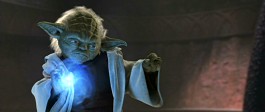 All of the programs seemed to be compelling and entertaining, and they all felt appropriately candid. Even the puffiest of the bunch – the fourth, which chats about Hayden Christensen and tells us how terrific he is – includes some cool shots from the set and other details. In that featurette, we also get to see a little of Christensen's screentest. Of course, we’re not going to get any real dirt, but these segments lacked that “sanitized” tone that harms so many documentaries. Some of the material appeared elsewhere as well, but most of it seemed exclusive to these shows, and all of it was very informative and enjoyable. The segments about the extras and the digital photography stand out as my favorites, but I think all of the featurettes seem entertaining and lively. Taken as a whole, these programs probably offer the most informative and compelling parts of this DVD.
All of the programs seemed to be compelling and entertaining, and they all felt appropriately candid. Even the puffiest of the bunch – the fourth, which chats about Hayden Christensen and tells us how terrific he is – includes some cool shots from the set and other details. In that featurette, we also get to see a little of Christensen's screentest. Of course, we’re not going to get any real dirt, but these segments lacked that “sanitized” tone that harms so many documentaries. Some of the material appeared elsewhere as well, but most of it seemed exclusive to these shows, and all of it was very informative and enjoyable. The segments about the extras and the digital photography stand out as my favorites, but I think all of the featurettes seem entertaining and lively. Taken as a whole, these programs probably offer the most informative and compelling parts of this DVD.
Next we encounter a domain called Dex’s Kitchen and Still Galleries. The Still Galleries split into three areas. The “Exclusive Production Photos” provided 86 stills from the set. These were all candid images with none of the usual bland promotional shots, and they all provided helpful captions. One nice touch stemmed from the viewer’s ability to zoom in on the photos and eliminate the captions if desired; this helped allow them to maximize the onscreen real estate. “One-Sheet Posters” offered 31 frames, though most of those showed the same image; the collection displayed the main poster with the title and credits translated into 30 different languages. The “International Outdoor Campaign” includes 13 shots used to promote the movie internationally; most entertaining are those adapted to tie in with the 2002 soccer World Cup.
Once we move to “Dex’s Kitchen”, we get a few extra pieces. Films Are Not Released; They Escape provides a solid 25-minute and 40-second documentary about the audio of Clones. It mixes the usual complement of behind-the-scenes footage and interviews; we hear from George Lucas, Ben Burtt, supervising sound editor Matthew Wood, sound effects editor Bruce Lacey, foley artist Dennie Thorpe, and re-recording mixers Gary Rydstrom and Michael Semanick. After a general introduction, the program progresses through seven different areas: sound recording, sound design, ADR, sound effects editing, foley recording, alien language creation, and final mix.
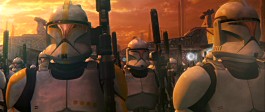 As I alluded earlier, I find sound design to be very interesting, and “Escape” offers a fine look at the subject. It leads us through all of the challenges created by a film such as Clones in a brisk manner but it still manages to cover them well. The glimpse of the looping sessions seems fun, and the view of how they invent alien languages also works especially well. The show really lets us see how much work goes into this area, and it’s a valuable look at the subject.
As I alluded earlier, I find sound design to be very interesting, and “Escape” offers a fine look at the subject. It leads us through all of the challenges created by a film such as Clones in a brisk manner but it still manages to cover them well. The glimpse of the looping sessions seems fun, and the view of how they invent alien languages also works especially well. The show really lets us see how much work goes into this area, and it’s a valuable look at the subject.
Actually, “Escape” highlights a theme that shows up in all of the DVD’s documentaries: just how heavily involved Lucas becomes in each area of the film’s creation. He really seems to micromanage things, and he appears to dictate virtually every decision related to the movie, no matter how small. Whether or not this makes the movies better I can’t say, but I felt amazed at just how deeply occupied with matters he becomes.
(By the way, am I the only one who thinks it seems strange that Lucas pronounces many Star Wars words differently than everyone else? For example, he calls it “Nay-BOO” instead of “Naa-boo”, and he refers to “Doe-koo” instead of “Doo-koo”. Since they’re his babies, shouldn’t we all use his pronunciations? Instead, he becomes the odd man out, as we never hear his versions anywhere else. He also calls lightsabers “laser swords” most of the time.)
Episode II Visual Effects Breakdown Montage gives us a succession of “before and after” shots from the film. The three-minute and 38-second piece seems compelling as it lets us quickly watch the progression of these scenes.
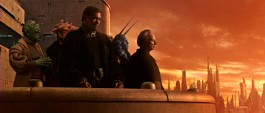 R2-D2: Beneath the Dome promotes a piece to appear on starwars.com. This six-minute and three-second trailer gives us a look at a Behind the Music style program about all of R2’s personal flaws and his diva-esque behavior. Frankly, I think this short piece is enough. It’s not an original concept – a promotional featurette for Gremlins 2 pushed the conceit that Gizmo was arrogant and egotistical – but this brief clip seems fairly amusing. However, I can’t imagine it’d be too much fun in a longer format; the gag would get old pretty quickly.
R2-D2: Beneath the Dome promotes a piece to appear on starwars.com. This six-minute and three-second trailer gives us a look at a Behind the Music style program about all of R2’s personal flaws and his diva-esque behavior. Frankly, I think this short piece is enough. It’s not an original concept – a promotional featurette for Gremlins 2 pushed the conceit that Gizmo was arrogant and egotistical – but this brief clip seems fairly amusing. However, I can’t imagine it’d be too much fun in a longer format; the gag would get old pretty quickly.
Theatrical Trailers and TV Spots includes three teasers plus one full trailer. I’d never actually seen these, as I purposefully avoided them in theaters; I wanted to know as little as possible about Clones before I saw it, so I refused to watch the ads. In addition, a music video for “Across the Stars” – a collection of different themes from the film – appeared. It was pretty unspectacular, as it combined movie clips and behind the scenes shots for a lackluster presentation. Possibly most annoying was the fact that lots of dialogue and other intrusive auditory elements detracted from the music.
The TV Spots area added many other promos. The “Character Campaign” offered eight different ads, each of which focused on a particular Clones character (or characters, in the case of the clones themselves). The other four TV spots fell under the category of “Action” and followed more traditional methods of movie promotion; each came across like an abbreviated trailer. The Yoda ad that spoofs Spider-Man seemed amusing.
An additional Easter Eggs cropped up on DVD Two. Go to “Dex’s Kitchen and Still Galleries” and head “To Dex’s Kitchen” specifically. Highlight “Main Menu” on this screen and click to the left. This will access a flyer on the wall behind Dex. Hit “enter” and you’ll get to see a clever and hilarious ad campaign run on college campuses. These crude-looking flyers tout the film in varied and amusing ways, and all list different Internet addresses like “droidtutor.com”. (Yes, the links actually work.)
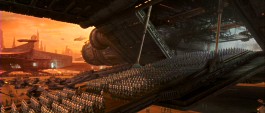 Since the supplemental content of Clones pretty closely matches that of Menace, I wanted to explain why the latter got an “A+” for extras but I bumped down that grade to an “A” for the former. Two words: “The Beginning”. While Clones pours on documentary content – we get a whopping 193 minutes of footage in that vein – it lacks anything quite as dazzling as the excellent program seen on Menace. Frankly, that one program pushed Menace to the top of the pile in the supplements department. Without such a piece, Clones will have to be content with its “A”.
Since the supplemental content of Clones pretty closely matches that of Menace, I wanted to explain why the latter got an “A+” for extras but I bumped down that grade to an “A” for the former. Two words: “The Beginning”. While Clones pours on documentary content – we get a whopping 193 minutes of footage in that vein – it lacks anything quite as dazzling as the excellent program seen on Menace. Frankly, that one program pushed Menace to the top of the pile in the supplements department. Without such a piece, Clones will have to be content with its “A”.
It’s not like that’s a bad grade, and overall, Attack of the Clones offers an absolutely top-notch DVD. As for my opinions of the movie itself, they remain in flux. I didn’t care for the flick much when I saw it theatrically, but I found it to seem substantially more compelling during my second viewing. I’d now put it at least on a par with The Phantom Menace, which may sound like faint praise, but since I actually enjoyed that picture, it really is a compliment. Actually, since I’ve liked Menace less with each subsequent screening, there’s a good shot that I’ll eventually prefer Clones to it.
In regard to the DVD, I feel no qualms whatsoever. The all-digital video presentation seems stunning, as it presents virtually no flaws and maintains a consistently crisp and lively image. The audio appears even better. Just like Menace, it offers a smooth and seamless soundfield and packs a real punch as it also balances the sound perfectly. The package concludes with a deep and entertaining roster of supplements that makes Attack of the Clones one of the strongest DVDs on the market. Despite a few lingering reservations about the movie itself, I really liked this product, and I definitely recommend Clones.



